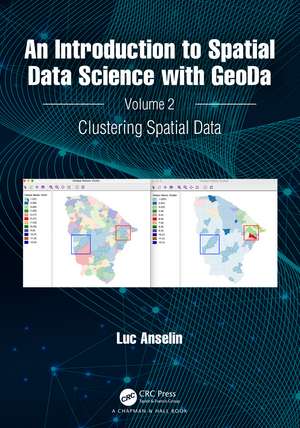An Introduction to Spatial Data Science with GeoDa: Volume 2: Clustering Spatial Data
Autor Luc Anselinen Limba Engleză Hardback – 29 mai 2024
The distinctive aspects of the book are both to explore ways to spatialize classic clustering methods through linked maps and graphs, as well as the explicit introduction of spatial contiguity constraints into clustering algorithms. Leveraging a large number of real-world empirical illustrations, readers will gain an understanding of the main concepts and techniques and their relative advantages and disadvantages. The book also constitutes the definitive user’s guide for these methods as implemented in the GeoDa open source software for spatial analysis.
It is organized into three major parts, dealing with dimension reduction (principal components, multidimensional scaling, stochastic network embedding), classic clustering methods (hierarchical clustering, k-means, k-medians, k-medoids and spectral clustering), and spatially constrained clustering methods (both hierarchical and partitioning). It closes with an assessment of spatial and non-spatial cluster properties.
The book is intended for readers interested in going beyond simple mapping of geographical data to gain insight into interesting patterns as expressed in spatial clusters of observations. Familiarity with the material in Volume 1 is assumed, especially the analysis of local spatial autocorrelation and the full range of visualization methods.
| Toate formatele și edițiile | Preț | Express |
|---|---|---|
| Hardback (3) | 572.72 lei 3-5 săpt. | +25.43 lei 4-10 zile |
| CRC Press – 29 mai 2024 | 572.72 lei 3-5 săpt. | +25.43 lei 4-10 zile |
| CRC Press – 26 apr 2024 | 576.47 lei 3-5 săpt. | +39.07 lei 4-10 zile |
| CRC Press – 30 mai 2024 | 786.63 lei 6-8 săpt. |
Preț: 572.72 lei
Preț vechi: 629.37 lei
-9% Nou
Puncte Express: 859
Preț estimativ în valută:
109.69€ • 113.01$ • 91.88£
109.69€ • 113.01$ • 91.88£
Carte disponibilă
Livrare economică 03-17 februarie
Livrare express 17-23 ianuarie pentru 35.42 lei
Preluare comenzi: 021 569.72.76
Specificații
ISBN-13: 9781032713021
ISBN-10: 103271302X
Pagini: 230
Ilustrații: 388
Dimensiuni: 178 x 254 x 21 mm
Greutate: 0.59 kg
Ediția:1
Editura: CRC Press
Colecția Chapman and Hall/CRC
Locul publicării:Boca Raton, United States
ISBN-10: 103271302X
Pagini: 230
Ilustrații: 388
Dimensiuni: 178 x 254 x 21 mm
Greutate: 0.59 kg
Ediția:1
Editura: CRC Press
Colecția Chapman and Hall/CRC
Locul publicării:Boca Raton, United States
Public țintă
Postgraduate and Professional Practice & DevelopmentCuprins
1. Introduction
Part 1: Dimension Reduction
2. Principal Component Analysis (PCA)
3. Multidimensional Scaling (MDS)
4. Stochastic Neighbor Embedding (SNE)
Part 2: Classic Clustering
5. Hierarchical Clustering Methods
6. Partioning Clustering Methods
7. Advanced Clustering Methods
8. Spectral Clustering
Part 3: Spatial Clustering
9. Spatializing Classic Clustering Methods
10. Spatially Constrained Clustering - Hierarchical Methods
11. Spatially Constrained Clustering - Partitioning Methods
Part 4: Assessment
12. Cluster Validation
Part 1: Dimension Reduction
2. Principal Component Analysis (PCA)
3. Multidimensional Scaling (MDS)
4. Stochastic Neighbor Embedding (SNE)
Part 2: Classic Clustering
5. Hierarchical Clustering Methods
6. Partioning Clustering Methods
7. Advanced Clustering Methods
8. Spectral Clustering
Part 3: Spatial Clustering
9. Spatializing Classic Clustering Methods
10. Spatially Constrained Clustering - Hierarchical Methods
11. Spatially Constrained Clustering - Partitioning Methods
Part 4: Assessment
12. Cluster Validation
Notă biografică
Luc Anselin is the Founding Director of the Center for Spatial Data Science at the University of Chicago, where he is also Stein-Freiler Distinguished Service Professor of Sociology and the College, as well as a member of the Committee on Data Science. He is the creator of the GeoDa software and an active contributor to the PySAL Python open source software library for spatial analysis. He has written widely on topics dealing with the methodology of spatial data analysis, including his classic 1988 text on Spatial Econometrics. His work has been recognized by many awards, such as his election to the U.S. National Academy of Science and the American Academy of Arts and Science.
Descriere
This book is the second in a two-volume series that introduces the field of spatial data science. It moves beyond pure data exploration to the organization of observations into meaningful groups, i.e., spatial clustering. This constitutes a major aspect of modern machine learning.
